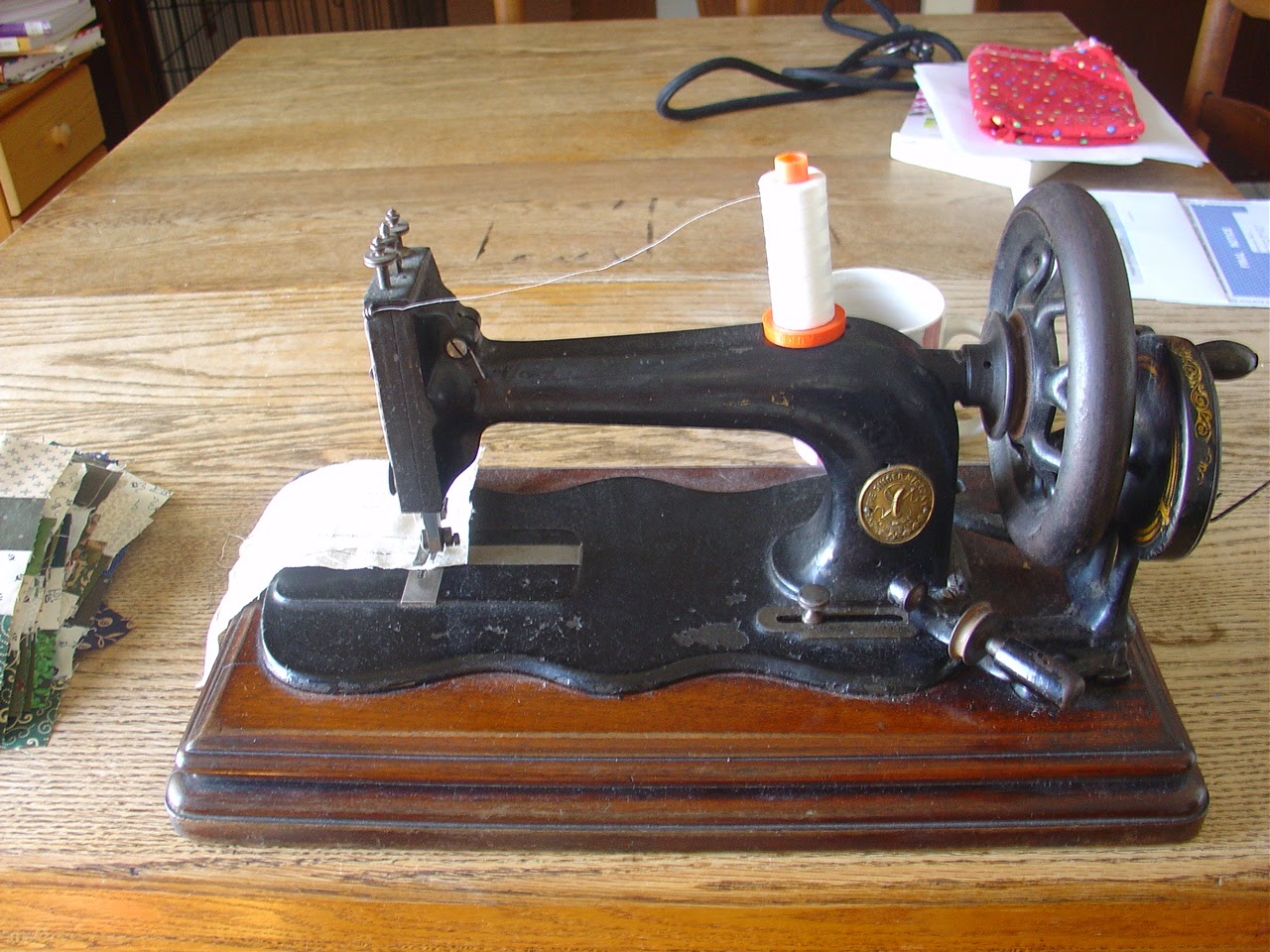The blocks in this quilt are made from leftovers from part 3 of the Grand Illusion Mystery Quilt by Bonnie Hunter.
We were supposed to make 120 units that look like this--one blue, 4 greens, 3 neutrals.
I kind of got stuck on this part. The piecing was easy, but I was making each part on a different people-powered machine, and for this one I chose my oldest treadle, a Singer model 12.
This is a picture I took while making these blocks. Bonnie's directions had us sew sets of 4 strips together and cut them into sections. It worked better for me to make 2-strip sets and cut pairs to sew together.
This machine was made in 1876, and is nicknamed Lorena. She needed a little more oil, and sewed just fine, but she was a little balky about winding bobbins. You use your left thumb or forefinger to apply tension when winding the bobbin, and your right hand to press the bobbin winder (that stickety-out thing on the right of the picture) against the hand wheel. If the machine isn't running very smoothly, the wheel won't turn freely.
So what to do with the leftovers? I had 60 sets made. So I turned them into 30 blocks, like this:
The squares in this block measure 1.5 in. finished, and the block itself finishes at 6 in. square.
According to Barbara Brackman's Encyclopedia of Pieced Quilt Patterns, this is a variation of block 1102a, which is called Mosaic #20.
By the way, this particular block is a leftover of the leftovers. The flag square has a tuck in it--oops! This may be destined to become a pot holder.
Lorena, the model 12 treadle, lives in my basement. About the time I was working on these blocks, we got a real cold snap, with lots of below zero temperatures. It was just too cold to work in the basement, so I brought my model 12 hand crank upstairs and finished the blocks on it. This is a real Frankenstein of a hand crank, with the parts of at least 3 machines. (I call her Frankencrankin.)
I made 20 more blocks, for a total of 50.
Here's how I set the blocks together.
It's a little wrinkled from being folded. I positioned the blocks with the blue corners touching.
I love this setting fabric! It comes from my favorite quilt shop in the world, J. J. Stitches in Sun Prairie, Wisconsin, and was designed by the shop owner, Julie Hendricksen.
Now I have to figure out the border, and then get going on the quilting. The quilt is a small twin size, so it should be too hard to quilt on my home machine.
One of the reasons I simply had to have my model 12 treadle was the folding top. Want to see?
Here's what she looks like, all closed up and locked (the key is in the lock here).When you unlock the top, the front folds back and the sides fold down.
The sides are ready to fold back, and the front is leaning against the wall here. It eventually folds completely down behind the machine. It locks against the other section so it stays in place.
And here's how it usually looks, with the top folded flat to become a sewing surface. Isn't this cool?
Sad to say, I don't use Lorena to sew very often. I can't buy new needles for her, although I have a small supply of new old stock. It's amazing how well she sews after nearly 140 years.
Good news for me--leftover lasagna and French bread for lunch!
What's under your needle this week?








 I
I 



Your quilt top looks wonderful and I love your treadle and hand crank girls! I agree with you completely about using up scraps of fabric!! A few weeks ago I did a nine patch on point on my treadle Singer 66. That'll go on my longarm soon to be quilted. This morning I finished quilting a DWR for my DDL...now to trim the edges then on to binding. :)
ReplyDeleteWow, sounds like you're really making progress!
DeleteI am extremely impressed along with your writing abilities, Thanks for this great share.
ReplyDelete